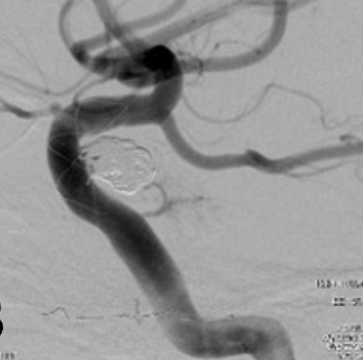Traumatic intracranial aneurysms associated with traffic accidents and endovascular management options
DOI:
https://doi.org/10.55005/sjns.v1i1.5Abstract
Traumatic intracranial pseudoaneurysms are rare complications of head injuries following traffic accidents, occurring in less than 1% of all cerebral aneurysms. Most cases are associated with fracture of the skull. Rupture of these traumatic aneurysms occur in up to 50% of all cases and are typically delayed from days to weeks following the initiating trauma. Traumatic pseudoaneurysms are often called a pulsating hematoma, which occurs when the arterial wall is ruptured by trauma and bleeding is confined only by the adventitia or surrounding tissues. Unlike the structure of a true aneurysm, that has all anatomical layers, the wall of a traumatic intracranial pseudoaneurysm is composed mainly of blood clot and a small amount of fibrous tissue. Difficult diagnosis, delayed presentation and poor outcomes contribute to overall prognosis of these traumatic intracranial aneurysms.
We investigated the patients with traumatic intracranial aneurysms developed after traffic accidents and treated with endovascular embolization in our Institution, with a review of literature and discussion of management options.
As traumatic intracranial aneurysms may present both diagnostic challenges and surgical difficulties, especially after polytrauma cases, rarely being appropriate for conservative treatment, early and precise diagnosis with cerebral angiography and prompt treatment are essential for good prognosis. Due to its nature to be fragile and prone to rupture, careful and precise endovascular embolization is thus a method of choice for treatment of these pseudoaneurysms.
References
Vella M. A., Crandall M. L.Patel M. B. Acute Management of Traumatic Brain Injury. Surg Clin North Am, 2017. 97(5): p. 1015-1030. DOI: 10.1016/j.suc.2017.06.003.
Rathlev N. K., Medzon R.Bracken M. E. Evaluation and management of neck trauma. Emerg Med Clin North Am, 2007. 25(3): p. 679-94, viii. DOI: 10.1016/j.emc.2007.06.006.
Purgina B.Milroy C. M. Fatal traumatic aneurysm of the posterior inferior cerebellar artery with delayed rupture. Forensic Sci Int, 2015. 247: p. e1-5. DOI: 10.1016/j.forsciint.2014.11.003.
Dubey A., Sung W. S., Chen Y. Y., Amato D., Mujic A., Waites P., et al. Traumatic intracranial aneurysm: a brief review. J Clin Neurosci, 2008. 15(6): p. 609-12. DOI: 10.1016/j.jocn.2007.11.006.
Lee S. H., Moon J. U., Choi S. K., Choi M. K., Lee J.Sung J. Y. Pseudoaneurysm at the Distal Posterior Inferior Cerebellar Artery After Blunt Head Trauma: A Case Report and Review of the Literature. World Neurosurg, 2016. 92: p. 580 e11-580 e15. DOI: 10.1016/j.wneu.2016.06.054.
Han J. H., Koh E. J., Choi H. Y., Park J. S.Lee J. M. Visualization of a Traumatic Pseudoaneurysm at Internal Carotid Artery Bifurcation due to Blunt Head Injury: A Case Report. Korean J Neurotrauma, 2014. 10(2): p. 126-9. DOI: 10.13004/kjnt.2014.10.2.126.
Moon T. H., Kim S. H., Lee J. W.Huh S. K. Clinical Analysis of Traumatic Cerebral Pseudoaneurysms. Korean J Neurotrauma, 2015. 11(2): p. 124-30. DOI: 10.13004/kjnt.2015.11.2.124.
Kumar A., Jakubovic R., Yang V.Dacosta L. Traumatic anterior cerebral artery aneurysms and management options in the endovascular era. J Clin Neurosci, 2016. 25: p. 90-5. DOI: 10.1016/j.jocn.2015.05.063.
Larson P. S., Reisner A., Morassutti D. J., Abdulhadi B.Harpring J. E. Traumatic intracranial aneurysms. Neurosurg Focus, 2000. 8(1): p. e4. DOI: 10.3171/foc.2000.8.1.1829.
Tureyen K. Traumatic intracranial aneurysm after blunt trauma. Br J Neurosurg, 2001. 15(5): p. 429-31. DOI: 10.1080/02688690120082440.
Kumar M.Kitchen N. D. Infective and traumatic aneurysms. Neurosurg Clin N Am, 1998. 9(3): p. 577-86.
Kikkawa Y., Natori Y.Sasaki T. Delayed post-traumatic pseudoaneurysmal formation of the intracranial ophthalmic artery after closed head injury. Case report. Neurol Med Chir (Tokyo), 2012. 52(1): p. 41-3. DOI: 10.2176/nmc.52.41.
Pozzati E., Gaist G.Servadei F. Traumatic aneurysms of the supraclinoid internal carotid artery. J Neurosurg, 1982. 57(3): p. 418-22. DOI: 10.3171/jns.1982.57.3.0418.
Prasad V., Gandhi D., Jindal G. Pipeline endovascular reconstruction of traumatic dissecting aneurysms of the intracranial internal carotid artery. BMJ Case Rep, 2013. DOI: 10.1136/bcr-2013-010899.
Kray JE., Dombrovskiy V., Vogel TR. Carotid artery dissection and motor vehicle trauma: patient demographics, associated injuries and impact of treatment on cost and length of stay. BMC Emerg Med, 2016. 16(1): p. 23. DOI: 10.1186/s12873-016-0088-z.
Morard M.de Tribolet N. Traumatic aneurysm of the posterior inferior cerebellar artery: case report. Neurosurgery, 1991. 29(3): p. 438-41. DOI: 10.1097/00006123-199109000-00018.
Lath R., Vaniprasad A., Kat E.Brophy B. P. Traumatic aneurysm of the callosomarginal artery. J Clin Neurosci, 2002. 9(4): p. 466-8. DOI: 10.1054/jocn.2001.1050.
du Trevou M. D.van Dellen J. R. Penetrating stab wounds to the brain: the timing of angiography in patients presenting with the weapon already removed. Neurosurgery, 1992. 31(5): p. 905-11; discussion 911-2. DOI: 10.1227/00006123-199211000-00012.
Uzan M., Cantasdemir M., Seckin M. S., Hanci M., Kocer N., Sarioglu A. C., et al. Traumatic intracranial carotid tree aneurysms. Neurosurgery, 1998. 43(6): p. 1314-20; discussion 1320-2. DOI: 10.1097/00006123-199812000-00024.
Hopkins J. K., Shaibani A., Ali S., Khawar S., Parkinson R., Futterer S., et al. Coil embolization of posttraumatic pseudoaneurysm of the ophthalmic artery causing subarachnoid hemorrhage. Case report. J Neurosurg, 2007. 107(5): p. 1043-6. DOI: 10.3171/JNS-07/11/1043.
Wang X., Chen J. X., You C.He M. Surgical management of traumatic intracranial pseudoaneurysms: a report of 12 cases. Neurol India, 2008. 56(1): p. 47-51. DOI: 10.4103/0028-3886.39312.

Downloads
Published
How to Cite
Issue
Section
License
Copyright (c) 2022 Filip Vitošević, Svetlana Milošević-Medenica

This work is licensed under a Creative Commons Attribution 4.0 International License.
Authors retain copyright of their work, with first publication rights granted to the publisher.






